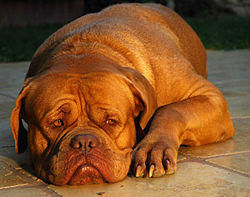The Newfoundland is a breed of large dog. Newfoundlands can be black, brown, grey, or black and white. They were originally bred and used as a working dog for fishermen in the Colony of Newfoundland, now part of Canada. They are known for their giant size, tremendous strength, calm dispositions, and loyalty. Newfoundland dogs excel at water rescue/lifesaving due to their muscular build, thick coat, webbed feet, and innate swimming abilities.
Description
AppearanceNewfoundlands ('Newfs', 'Newfies') have webbed feet and a water-resistant coat.[2] Males weigh 60–70 kg (130–150 lb), and females 45–55 kg (100–120 lb), placing them in the "Giant" weight range. Some Newfoundland dogs have been known to weigh over 90 kg (200 lb). The largest Newfoundland on record weighed 120 kg (260 lbs) and measured over 6 feet from nose to tail, ranking it among the biggest Molossers. They may grow up to 22–28 inches tall at the shoulder.
The American Kennel Club (AKC) standard colors of the Newfoundland dogs are black, brown, gray, and landseer (black or brown head and white and black or brown body); The Kennel Club (KC) permits only black, brown, and landseer; the Canadian Kennel Club (CKC) permits are only black and landseer. The Landseer is named after the artist Sir Edwin Henry Landseer, who featured them in many of his paintings. AKC, CKC, and KC all treat Landseer as part of the breed. Fédération Cynologique Internationale (FCI) consider the Landseer to be a separate breed; others consider it only a Newfoundland color variation.
The Newfoundland's extremely large bones give it mass, while his large musculature gives it the power he needs to take on rough ocean waves and powerful tides. These dogs have great lung capacity for swimming extremely long distances, and a thick, oily and waterproof double coat which protects them from the chill of icy waters. The droopy lips and jowls make the dog drool.
In the water, the dog's massive webbed paws give it maximum propulsion. The swimming stroke is not an ordinary dog paddle. Unlike other dogs, the Newfoundland moves his limbs in a down-and-out motion, which can be seen as a modified breaststroke. This gives it more power with every stroke.
Temperament
The Newfoundland dog is legendarily known for its calm nature and its strength. It is for this reason that this breed is known as "the gentle giant". International kennel clubs generally describe the breed as having a sweet temper.[2][3][4] It typically has a deep loud bark, is easy to train if started young, makes a fine guardian or watchdog. It is exceptionally good with children, giving it the nickname "the nanny dog." The breed was memorialized in "Nana," the beloved dog guardian in Peter Pan.
The Newfoundland dog is also extremely good with other animals. Its caring and gentle nature comes out in play and interaction with humans and animals alike. As with any breed, the Newfoundland can have dominance issues, but this is unusual for the breed.
Health
Newfoundland Dog StampThere are several health problems associated with Newfoundlands. Newfoundlands are prone to hip dysplasia (a malformed ball and socket in the hip joint). They also get Elbow dysplasia, and cystinuria (a hereditary defect that forms calculi stones in the bladder). Another genetic problem is subvalvular aortic stenosis. This is a common heart defect in Newfoundlands involving defective heart valves. SAS can cause sudden death at an early age.








